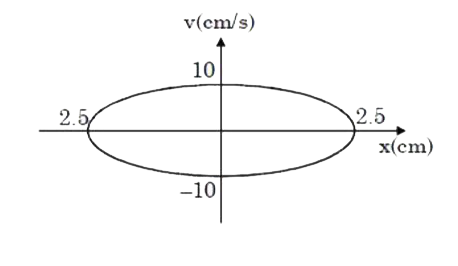The graph between kinetic energy and displacement of a particle performing S.H.M. is
parabola
straight line
ellipse
circle
The correct Answer is:A
To determine the graph between kinetic energy (KE) and displacement (x) of a particle performing Simple Harmonic Motion (SHM), we can follow these steps:
Step 1: Understand the Energy in SHM
In SHM, the total mechanical energy (E) of the system is constant and is the sum of kinetic energy (KE) and potential energy (PE). The potential energy in SHM is given by the formula:
PE=12kx2
where k is the spring constant and x is the displacement from the mean position.
Step 2: Write the Expression for Kinetic Energy
The total energy in SHM can be expressed as:
E=KE+PE
From this, we can express kinetic energy as:
KE=E−PE
Substituting the expression for potential energy, we get:
KE=E−12kx2
Step 3: Analyze the Equation
Since the total energy E is constant, we can rewrite the equation as:
KE=E−12kx2
This shows that kinetic energy is a function of displacement x. As x increases, the term 12kx2 increases, thus reducing the kinetic energy.
Step 4: Identify the Nature of the Graph
The equation KE=E−12kx2 can be rearranged to:
KE=−12kx2+E
This is a quadratic equation in terms of x and represents a downward-opening parabola. The maximum kinetic energy occurs when x=0 (the mean position), and it decreases to zero as x approaches the amplitude of the motion.
Step 5: Conclusion
Thus, the graph of kinetic energy versus displacement for a particle in SHM is a downward-opening parabola, with the maximum kinetic energy at the mean position and zero kinetic energy at the maximum displacement (amplitude).
Final Answer
The graph between kinetic energy and displacement of a particle performing SHM is a downward-opening parabola.
---
In SHM, the total mechanical energy (E) of the system is constant and is the sum of kinetic energy (KE) and potential energy (PE). The potential energy in SHM is given by the formula:
PE=12kx2
where k is the spring constant and x is the displacement from the mean position.
The total energy in SHM can be expressed as:
E=KE+PE
From this, we can express kinetic energy as:
KE=E−PE
Substituting the expression for potential energy, we get:
KE=E−12kx2
Since the total energy E is constant, we can rewrite the equation as:
KE=E−12kx2
This shows that kinetic energy is a function of displacement x. As x increases, the term 12kx2 increases, thus reducing the kinetic energy.
The equation KE=E−12kx2 can be rearranged to:
KE=−12kx2+E
This is a quadratic equation in terms of x and represents a downward-opening parabola. The maximum kinetic energy occurs when x=0 (the mean position), and it decreases to zero as x approaches the amplitude of the motion.
Thus, the graph of kinetic energy versus displacement for a particle in SHM is a downward-opening parabola, with the maximum kinetic energy at the mean position and zero kinetic energy at the maximum displacement (amplitude).
The graph between kinetic energy and displacement of a particle performing SHM is a downward-opening parabola.
Topper's Solved these Questions
Similar Questions
Knowledge Check
The graph between total energy and displacement of a particle performing S.H.M. is
AparabolaBstraight lineCellipseDcircleThe graph between potential energy and displacement of a particle performing S.H.M. is
AparabolaBstraight lineCellipseDcircleThe graph between instantaneous velocity and displacement of a particle performing S.H.M.with period 2πsecorω=1 is
AparabolaBstraight lineCellipseDcircle
The amplitude of particle performing S.H.M. is
View SolutionGraph between velocity and displacement of a particle, executing S.H.M. is
View SolutionThe graph between velocity and displacement of a particle executing S.H.M. of angular frequency 1 rad/s can be (where A is the amplitude of displacement)
View SolutionKinetic energy of the particle performing S.H.M. is
View SolutionThe graph plotted between acceleration and displacement of a particle in SHM is
View Solution

